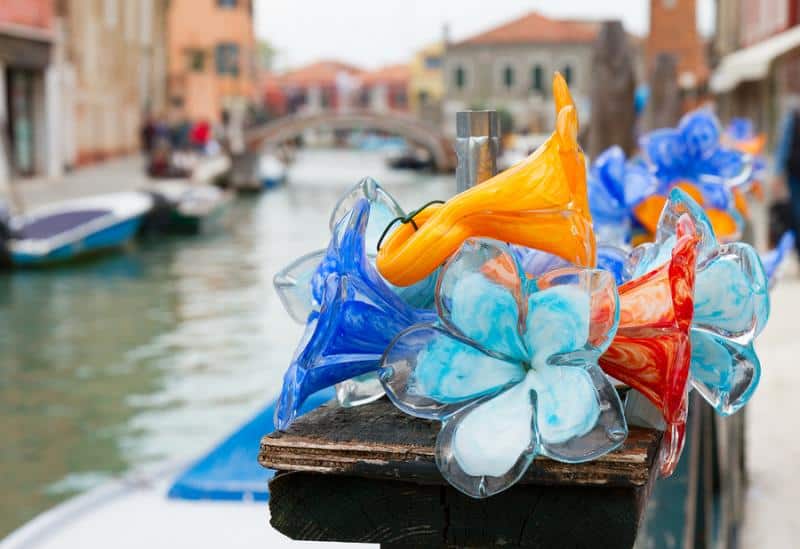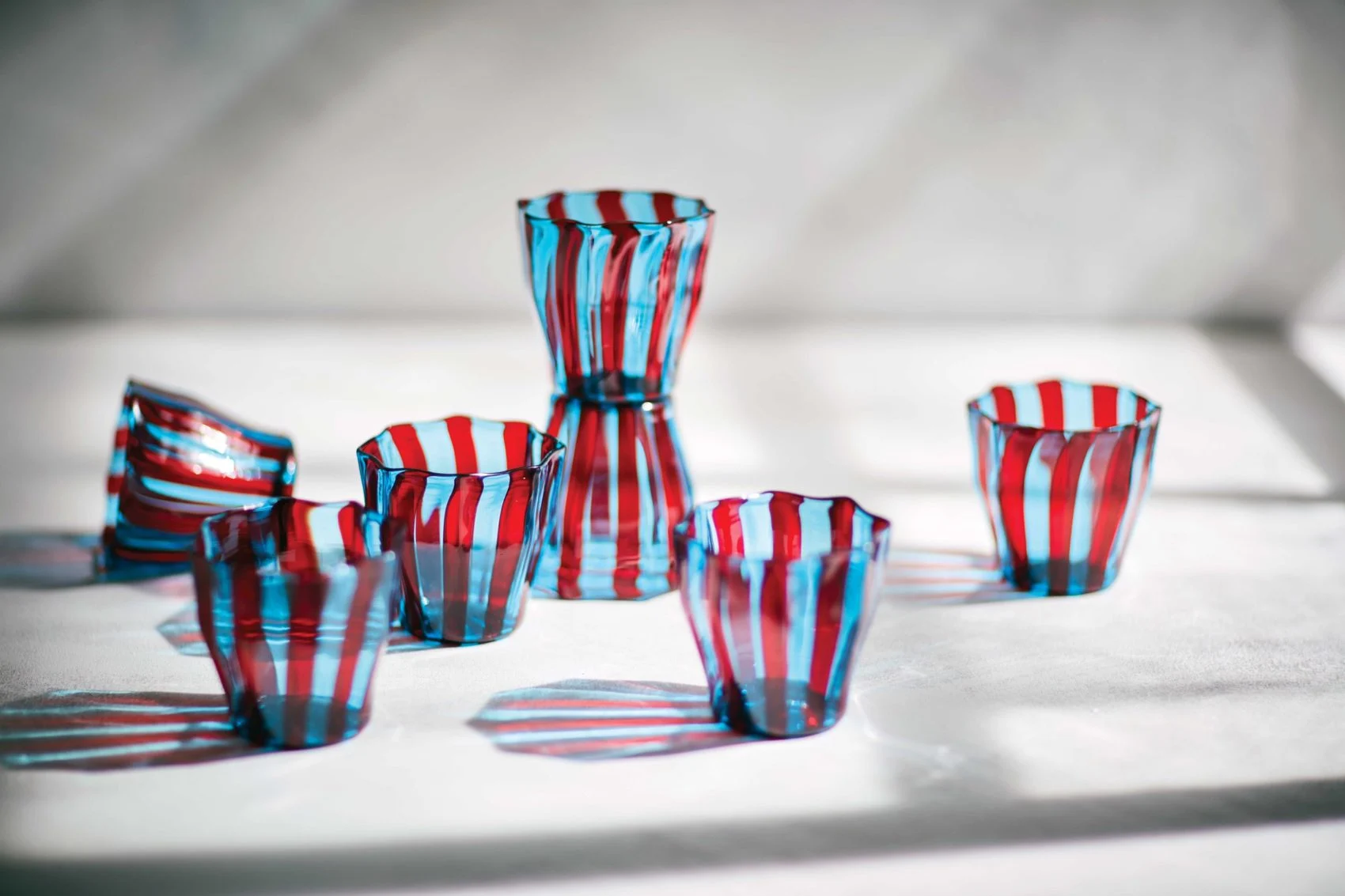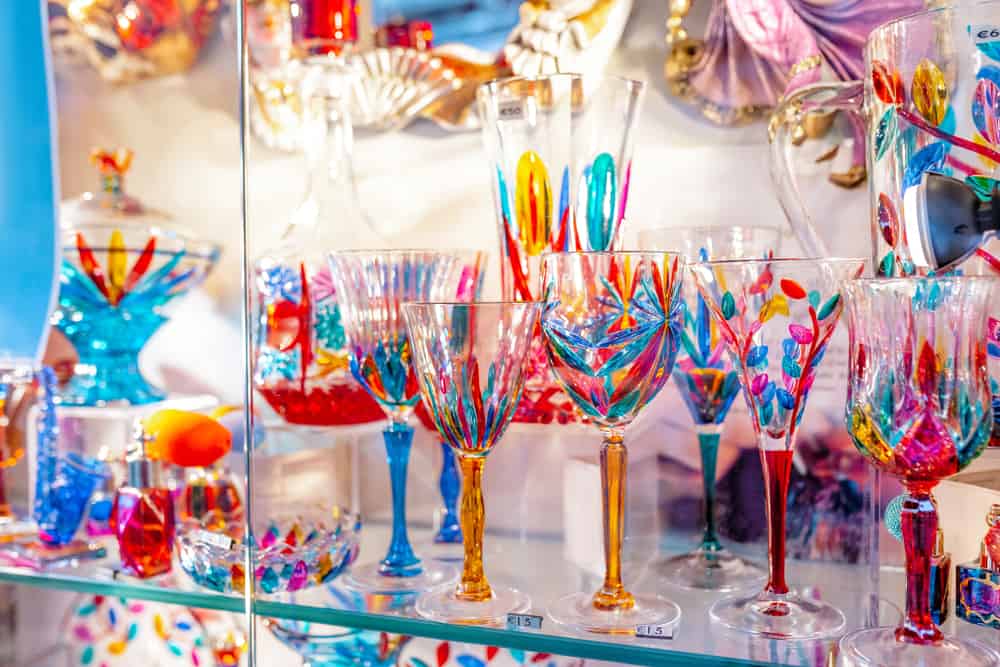Murano glass has a long and fascinating history, as well as a distinct tradition. It’s a unique art form, and the technique for working with glass has been recognized and admired since its inception.
Murano glass is unmistakably a symbol of refinement and beauty. It’s also one of the artifacts that pique collectors’ attention the most.
However, the Venetian masters’ approach has become so prized that numerous duplicates have been created over time. How can you tell whether it’s genuine Murano glass?
For years, Murano’s master artisans have fought counterfeiters and left various indicators to assist in identifying a genuine Murano work of art.
In this guide, we want to show you what are the basic notions that you must have to identify Murano glass labels and marks.
Being competent at identifying ancient objects is a real skill and Murano glass is no exception, but we are going to give you the basics to immerse yourself in this incredible world of Murano glass.
Table of Contents
Murano glass: what is it?
Murano glass is created on the Venetian island of Murano. It all began at the beginning of the thirteenth century when the fourth crusade’s crusaders attacked Constantinople.
Many great artisans who worked with glass were forced to flee the city during the heinous plundering. Several of them settled in Italy, and the Italians became professionals in the craft of glassmaking throughout time.
They developed a wide range of skills, and the movement increased even more when, two centuries later, another flood of craftsmen migrated due to the Ottoman Empire’s seizure of Constantinople.
The artisans had already organized themselves and had a substantial guild throughout the 200 years since the first masters arrived in Venice. Venice was the city in Italy that produced the most well-known works, and it grew in popularity over time.
By the end of the 13th century, all Venetian artisans had been ordered to relocate to Murano due to the risk of fire in the manufacturing workshops.
This is how Murano grew into a mini-nation of artisans dedicated to blowing glass and creating stunning works of art over the centuries. Murano is known for its chandeliers, lamps, sculptures, vases, jewelry, and ornaments, but they also make a wide range of other items.
Murano artisans were exempt from prosecution and given other advantages, including the ability to carry swords. They used to marry women from the most affluent Italian families as well.
However, the price was high. They were unable to leave Murano Island due to a royal decree. They did it to safeguard their company by preventing the technique from being copied elsewhere.
Although leaving Murano was punishable by death, many artisans took the risk and managed to flee, establishing studios in adjacent countries and spreading Murano art throughout Europe.
However, master craftsmen still dwell in Murano and are responsible for creating authentic Murano glass creations. Barovier & Toso for example is one of the oldest companies in the world, they started doing Murano glass IN 1295.
Are there any markings on Murano glass?

The good thing about this luxury item is that, because it has been famous for centuries and its master craftsmen are renowned artists, they have taken great care to instill each piece with so many distinct characteristics that anyone familiar with the subject will be able to recognize genuine Murano glass.
However, if you are new to this or an amateur who wants to learn more, there are specific clues that can help you determine whether or not you are dealing with an original piece.
Look for a trademark label to ensure that the people you’re buying from are legitimate Venetian glass exporters.
For example, Promoveto is a major consortium that issues these credentials to all workshops that meet the requirements to be deemed real Murano Glass manufacturers.
There is no longer a difficulty with current works of art. The originals normally have a digital code that may be used to verify their authenticity, and the majority of products are regulated.
If the marks on your Murano pieces are genuine, you’ll be able to find out everything you need to know about your piece, including which oven it came from and what manufacturing processes it went through. Ask always for a certificate of authenticity.
But what if I’m standing in front of a vintage Murano piece that doesn’t have a digital certificate?
Engravings and labels
Most Murano art pieces have labels and are etched into the glass. Artist names are often used and signatures are often diamond cut.
While stickers and labels are not entirely reliable, even if you see one that says it was made in Murano, don’t take it for granted because there are many fake labels in the market. Remember that many companies are wanting to fake Murano glass and there are excellent fakes, which are obvious to any connoisseur but not noticed by inexperienced eyes.
The labels on most Murano artworks are etched into the glass. Signatures are frequently diamond cut, and artist names are frequently utilized.
Even if you see a label that indicates it was created in Murano, don’t take it at its value. Keep in mind that many companies desire to duplicate Murano glass, and there are great fakes that are clear to any connoisseur yet go unnoticed by inexperienced eyes.
If you come across a label that indicates it’s from Murano, look to see if it includes the name of the workshop or the artist who created it, as most labels include this information. You can also find these scripts in a label “Vetro Eseguito Secondo La Tecnica Dei Maestri Di Murano” . That means that was inspired by Murano´s technique but is not a real Murano.
It must also state that it was created in Murano. Some labels merely say Italy instead of Murano, which is almost certainly fraudulent.
Some pieces are hand-marked with the number of the oven in which they were created so that they may be traced back to their source.
If the label states “Murano style,” it’s not authentic.
It’s also very likely that a label that says “Vetro Artistico Murano” is a fake. The label is used as a symbol of authenticity, but you simply have to pay a price to get it. As a result, many fakes pay a membership fee just to gain the seal, but it doesn’t indicate they’re selling genuine Murano glass.
Several websites offer a large collection of photos with actual labels indicating that the item was created in Murano. Check out their photo banks, since they have a large collection and can greatly assist you in identifying fakes.
How can you tell whether it’s genuine Murano glass?

There is more than one way to identify a real piece of Murano glass, not just based on its label. These are another of the clues that Venetian artists have left in their works of art to be identified.
By their Colors
True Murano glass artisans use different minerals to color their creations through a manufacturing technique called Sommerso.
With this technique, the minerals melt giving specific shades to the transparent glass. There are characteristic colors in Murano art that are recognized by experts. Some of those colors are manganese pink or cobalt blue.
The master craftsmen also tend to add details in 24-carat gold or silver.
So an authentic piece will always have several layers of superimposed colors and some detail in gold or silver.
Imperfect Forms
Remember that each Murano piece is one-of-a-kind and unrepeatable and that they are handmade, so they will have small imperfections.
Look for bubbles in the glass or take note of its asymmetrical shape. Unlike produced imitations, its proportions will never be ideal.
Other marks, such as a pontil mark, are also worth investigating. The pontil is the tool that artists use to blow glass, and when cutting it, a little mark in the shape of a circle is frequently visible.
Even if you locate two things with the same model, they will differ in color tone, shape, size, or pattern if they are genuine.
Trust the Price
Remember that Murano glass is not a common item; it is a high-end work of art, and if you locate a piece that is significantly less expensive than the rest, it is almost certainly a fake.
Murano masters work to preserve and create art using traditional skills passed down from their fathers. It is a difficult and time-consuming task, and craftsmen frequently use gold and silver threads in their works of art, so they are not inexpensive, and the price will always give you a fair idea of whether you are dealing with a genuine piece.
Consult the Masters
We are no longer in the middle ages and the artisans of Murano are no longer prisoners on their island, so make use of technology and contact masters and workshops originating from Murano.
The masters in this art will be able to answer all your questions about the pieces made by them. They know the technique very well and can help you verify if what you have or want to buy is real Murano art.
What is the value of my Murano glass?
Murano glass prices vary depending on the scale and complexity of the work of art, but if you are considering purchasing a piece of Murano glass, you should expect to pay at least a few thousand dollars. Any piece that is significantly less expensive than the original is merely a knockoff.
Tips on buying from a trusted source
You’re suggested to purchase from a reputable store. Murano glass is mostly offered through museums, specialist stores, and authorized exporters. You should also keep in mind that if the store has a large selection of classic Murano art, the goods are most likely authentic.
If you opt to buy online, make certain that the company you purchase from has the part’s original certificates. Remember Murano glass factories are always located on Murano Island. Those who do not have Italy as their only base of operations frequently sell imitations.
We hope that this article has answered any questions you may have about how to spot genuine Murano glass. That we were able to broaden your understanding of original marks and labels, and that you now have a greater understanding of how to distinguish Murano’s work based on its features.
